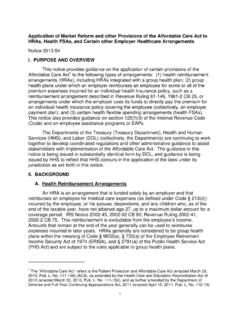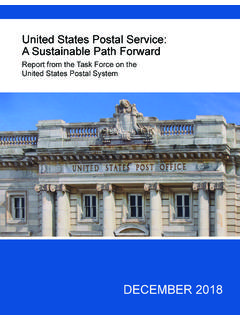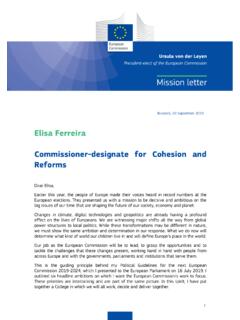Transcription of Basel Committee on Banking Supervision Consultative …
1 Basel Committee on Banking Supervision Consultative Document Standardised Measurement Approach for operational risk Issued for comment by 3 June 2016 March 2016 This publication is available on the BIS website ( ). Bank for International Settlements 2016. All rights reserved. Brief excerpts may be reproduced or translated provided the source is stated. ISBN 978-92-9197-424-5 (print) ISBN 978-92-9197-452-8 (online) Standardised Measurement Approach for operational risk iii Contents 1. Introduction .. 1 2. Withdrawal of internal modelling for operational risk regulatory capital from the Basel Framework .. 1 3. Next steps .. 2 4. The Standardised Measurement Approach (SMA) for operational risk.
2 3 The Business Indicator (BI) .. 3 The BI Component .. 5 The Internal Loss Multiplier and Loss Component .. 6 The SMA capital requirement .. 7 5. Application of the SMA within a group .. 8 6. Minimum standards for the use of loss data under the SMA .. 8 General criteria on loss data identification, collection and treatment .. 9 Specific criteria on loss data identification, collection and treatment .. 10 Annex 1 Business Indicator definitions .. 12 Annex 2 Example of an alternative method to help ensure the stability of the SMA methodology .. 14 Standardised Measurement Approach for operational risk 1 1. Introduction 1. Establishing consistency in the implementation of post-crisis regulatory reforms is an important focus of the Basel Committee .
3 Consistent application of global bank standards will improve the resilience of the global Banking system, promote public confidence in regulatory capital ratios and encourage a level playing field for internationally active banks. In October 2014, the Committee published for consultation a revised Standardised Approach for operational risk that sought to address weaknesses in the existing standardised In conjunction with that proposal, the Committee embarked on a review of the costs and benefits of the framework s Advanced Measurement Approaches (AMA) for operational risk. 2. A key outcome from the Committee s analysis is that the combination of a simple standardised measure of operational risk and bank-specific loss data provides a sufficiently risk sensitive measure of operational risk.
4 The Committee believes that this combination also meets its objectives of promoting comparability of risk-based capital measures and reducing model complexity. 3. Building on this finding, the Committee has developed the Standardised Measurement Approach (SMA), which provides a single non- model-based method for the estimation of operational risk capital. The SMA, which builds on the simplicity and comparability offered by a standardised approach, also incorporates the risk sensitivity of an advanced approach by combining in a standardised fashion the use of a bank s financial statement information and its internal loss experience. 4. Consistent with Part I (Scope of Application) of the Basel II framework,2 the proposed SMA framework would be applied to internationally active banks on a consolidated basis.
5 Supervisors retain discretion to apply the SMA framework to non-internationally active institutions. 2. Withdrawal of internal modelling for operational risk regulatory capital from the Basel Framework 5. Introduced as part of the Basel II framework in 2006, the AMA allows for the estimation of regulatory capital to be based on a diverse range of internal modelling practices subject to supervisory approval. Commensurate with the relative infancy of the field of operational risk measurement at the time, the AMA s principles-based framework was established with a significant degree of flexibility. This flexibility was expected to considerably narrow over time, and ultimately lead to the emergence of best practice.
6 6. A recent review of the measures related to banks operational risk modelling practices and capital outcomes revealed that the Committee s expectations failed to materialise. Supervisory experience with the AMA has been mixed. The inherent complexity of the AMA and the lack of comparability arising from a wide range of internal modelling practices have exacerbated variability in risk-weighted asset calculations, and have eroded confidence in risk-weighted capital ratios. The Committee has therefore determined that the withdrawal of internal modelling approaches for operational risk regulatory capital from the Basel Framework is warranted. 1 Operational risk - Revisions to the simpler approaches, October 2014, available at 2 Basel II: International Convergence of Capital Measurement and Capital Standards: A Revised Framework - Comprehensive Version, June 2006, available at 2 Standardised Measurement Approach for operational risk 7.
7 In the light of the Committee s findings, the estimation of regulatory capital for the entire operational risk framework has been standardised. The approach presented in this Consultative document combines the main elements of the previously consulted standardised approach with banks internal loss experience, which was a key component of the AMA. The Committee believes that, in addition to significantly improving the simplicity of the framework, the SMA embeds greater risk sensitivity in the standardised approach for operational risk and ensures greater comparability. 8. During the course of 2016, the Committee will provide further details on the timeline for the withdrawal of the AMA, and the implementation of the SMA.
8 3. Next steps 9. The Committee encourages market participants to engage in a constructive dialogue during the consultation period. Comments from the public are welcomed on all aspects of this Consultative document; comments on the proposals should be uploaded by Friday 3 June 2016 using the following link: All comments will be published on the website of the Bank for International Settlements unless a respondent specifically requests confidential treatment. 10. In its 11 January 2016 press release,3 the Committee s oversight body, the Group of Central Bank Governors and Heads of Supervision , noted the important work of the Committee to assess the quantitative impact of its proposed revisions to the regulatory framework.
9 The results of the quantitative impact study (QIS) related to the proposals set out in this Consultative document will be a key input to the final design and calibration of the operational risk framework. The QIS will help ensure that the framework produces capital requirements that are prudent and stable, while retaining risk-sensitivity. The objective of these proposals is to not significantly increase overall capital requirements. The impact, however, of the new operational risk framework will vary from bank to bank and may lead to an increase in minimum capital requirements for some banks. Once the Committee has reviewed responses to this second Consultative document and the QIS results, it intends to publish the final standard within an appropriate timeframe and provide sufficient time for implementation.
10 Before publication of the final standard, implementation arrangements (including the timetable) will be discussed by the Committee , taking into account the range of other reforms that have been, or are due to be, considered by the Committee . 3 See Standardised Measurement Approach for operational risk 3 4. The Standardised Measurement Approach (SMA) for operational risk 11. The SMA combines the Business Indicator (BI), a simple financial statement proxy of operational risk exposure, with bank-specific operational loss data. Since the October 2014 consultation, the structure of the BI has been revised to avoid penalising certain business models, such as those based on the distribution of products bought from third parties, and those based on high interest margins.

















